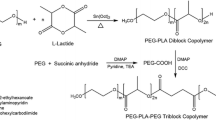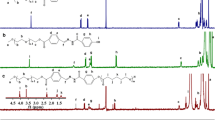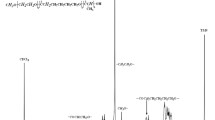ABSTRACT
Purpose
To test physicochemical and biological properties of PEG-poly(aspartate) [PEG-p(Asp)] block copolymer micelles entrapping doxorubicin hydrochloride (DOX) through ionic interaction.
Methods
PEG-p(Asp) was synthesized from 5 kDa PEG and 20 Asp units. Carboxyl groups of p(Asp) were present as benzyl ester [PEG-p(Asp/Bz)], sodium salt [PEG-p(Asp/Na)] or free acid [PEG-p(Asp/H)]. Block copolymers and DOX were mixed at various ratios to prepare polymer micelles, which were subsequently characterized to determine particle size, drug loading and release patterns, and cytotoxicity against prostate (PC3 and DU145) and lung (A549) cancer cell lines.
Results
PEG-p(Asp/Bz), Na- and H-micelles entrapped 1.1, 56.8 and 40.6 wt.% of DOX, respectively. Na- and H-micelles (<100 nm) showed time-dependent DOX release at pH 7.4, which was accelerated at pH 5.0. Na-micelles were most stable at pH 7.4, retaining 31.8% of initial DOX for 48 h. Cytotoxicity of Na-micelles was 23.2% (A549), 28.5% (PC3) and 45.9% (DU145) more effective than free DOX.
Conclusion
Ionic interaction appeared to entrap DOX efficiently in polymer micelles from PEG-p(Asp) block copolymers. Polymer micelles possessing counter ions (Na) of DOX in the core were the most stable, releasing drugs for prolonged time in a pH-dependent manner, and suppressing cancer cells effectively.








Similar content being viewed by others
REFERENCES
Lvov YM, Pattekari P, Zhang X, Torchilin V. Converting poorly soluble materials into stable aqueous nanocolloids. Langmuir. 2011;27:1212–7.
Cukierman E, Khan DR. The benefits and challenges associated with the use of drug delivery systems in cancer therapy. Biochem Pharmacol. 2010;80:762–70.
Jain RK. Delivery of molecular and cellular medicine to solid tumors. Adv Drug Deliv Rev. 1997;26:71–90.
Liu J, Xiao Y, Allen C. Polymer-drug compatibility: a guide to the development of delivery systems for the anticancer agent, ellipticine. J Pharm Sci. 2004;93:132–43.
Oberoi HS, Laquer FC, Marky LA, Kabanov AV, Bronich TK. Core cross-linked block ionomer micelles as ph-responsive carriers for cis-diamminedichloroplatinum(ii). J Control Release. 2011;153:64–72.
Ruenraroengsak P, Cook JM, Florence AT. Nanosystem drug targeting: facing up to complex realities. J Control Release. 2010;141:265–76.
Maruyama K. Intracellular targeting delivery of liposomal drugs to solid tumors based on epr effects. Adv Drug Deliv Rev. 2011;63:161–9.
Maeda H. Tumor-selective delivery of macromolecular drugs via the epr effect: background and future prospects. Bioconjugate Chem. 2010;21:797–802.
Torchilin V. Tumor delivery of macromolecular drugs based on the epr effect. Adv Drug Deliv Rev. 2011;63:131–5.
Blanco E, Hsiao A, Mann Aman P, Landry Matthew G, Meric-Bernstam F, Ferrari M. Nanomedicine in cancer therapy: innovative trends and prospects. Cancer Sci. 2011;102:1247–52.
Matsumura Y, Kataoka K. Preclinical and clinical studies of anticancer agent-incorporating polymer micelles. Cancer Sci. 2009;100:572–9.
Musacchio T, Torchilin Vladimir P. Recent developments in lipid-based pharmaceutical nanocarriers. Front Biosci. 2011;16:1388–412.
Seidlits S, Peppas NA. Star polymers and dendrimers in nanotechnology and drug delivery. Nanotechnol Ther. 2007;317–48.
Wong HL, Li Y, Bendayan R, Rauth MA, Wu XY. Solid lipid nanoparticles for anti-tumor drug delivery. Nanotechnol Cancer Ther. 2007;741–76.
Park K. All nanocarriers are created equal. J Control Release. 2008;130:139.
Chan Juliana M, Valencia Pedro M, Zhang L, Langer R, Farokhzad Omid C. Polymeric nanoparticles for drug delivery. Methods Mol Biol. 2010;624:163–75.
Levy-Nissenbaum E, Radovic-Moreno Aleksandar F, Wang Andrew Z, Langer R, Farokhzad Omid C. Nanotechnology and aptamers: applications in drug delivery. Trends Biotechnol. 2008;26:442–9.
Alexis F, Pridgen Eric M, Langer R, Farokhzad Omid C. Nanoparticle technologies for cancer therapy. Handb Exp Pharmacol. 2010;55–86.
Pirollo KF, Chang EH. Does a targeting ligand influence nanoparticle tumor localization or uptake? Trends Biotechnol. 2008;26:552–8.
Grattoni A, Shen H, Fine D, Ziemys A, Gill JS, Hudson L, et al. Nanochannel technology for constant delivery of chemotherapeutics: beyond metronomic administration. Pharm Res. 2011;28:292–300.
Dang TT, Bratlie KM, Bogatyrev SR, Chen XY, Langer R, Anderson DG. Spatiotemporal effects of a controlled-release anti-inflammatory drug on the cellular dynamics of host response. Biomaterials. 2011;32:4464–70.
Greco F, Vicent MJ, Gee S, Jones AT, Gee J, Nicholson RI, et al. Investigating the mechanism of enhanced cytotoxicity of hpma copolymer-dox-agm in breast cancer cells. J Control Release. 2007;117:28–39.
Murakami M, Cabral H, Matsumoto Y, Wu S, Kano MR, Yamori T, et al. Improving drug potency and efficacy by nanocarrier-mediated subcellular targeting. Sci Transl Med. 2011;3:64ra2.
van Vlerken Lilian E, Duan Z, Little Steven R, Seiden Michael V, Amiji Mansoor M. Augmentation of therapeutic efficacy in drug-resistant tumor models using ceramide coadministration in temporal-controlled polymer-blend nanoparticle delivery systems. AAPS J. 2010;12:171–80.
Lee HJ, Ponta A, Bae Y. Polymer nanoassemblies for cancer treatment and imaging. Ther Deliv. 2010;1:803–17.
Bae Y, Kataoka K. Intelligent polymeric micelles from functional poly(ethylene glycol)-poly(amino acid) block copolymers. Adv Drug Deliv Rev. 2009;61:768–84.
Yokoyama M. Polymeric micelles as a new drug carrier system and their required considerations for clinical trials. Expert Opin Drug Del. 2010;7:145–58.
Kataoka K, Kwon GS, Yokoyama M, Okano T, Sakurai Y. Block-copolymer micelles as vehicles for drug delivery. J Control Release. 1993;24:119–32.
Bae Y, Nishiyama N, Fukushima S, Koyama H, Yasuhiro M, Kataoka K. Preparation and biological characterization of polymeric micelle drug carriers with intracellular ph-triggered drug release property: tumor permeability, controlled subcellular drug distribution, and enhanced in vivo antitumor efficacy. Bioconjugate Chem. 2005;16:122–30.
Bae Y, Nishiyama N, Kataoka K. In vivo antitumor activity of the folate-conjugated ph-sensitive polymeric micelle selectively releasing adriamycin in the intracellular acidic compartments. Bioconjugate Chem. 2007;18:1131–9.
Bae Y, Alani AWG, Rockich NC, Lai TSZC, Kwon GS. Mixed ph-sensitive polymeric micelles for combination drug delivery. Pharm Res. 2010;27:2421–32.
Alani AWG, Bae Y, Rao DA, Kwon GS. Polymeric micelles for the ph-dependent controlled, continuous low dose release of paclitaxel. Biomaterials. 2010;31:1765–72.
Howard MD, Ponta A, Eckman A, Jay M, Bae Y. Polymer micelles with hydrazone-ester dual linkers for tunable release of dexamethasone. Pharm Res. 2011;28:2435–46.
Ponta A, Bae Y. Peg-poly(amino acid) block copolymer micelles for tunable drug release. Pharm Res. 2010;27:2330–42.
Allen C, Maysinger D, Eisenberg A. Nano-engineering block copolymer aggregates for drug delivery. Colloid Surface B. 1999;16:3–27.
Yokoyama M, Inoue S, Kataoka K, Yui N, Sakurai Y. Preparation of adriamycin-conjugated poly(ethylene glycol)-poly(aspartic acid) block copolymer - a new type of polymeric anticancer agent. Makromol Chem-Rapid. 1987;8:431–5.
Kwon GS, Yokoyama M, Okano T, Sakurai Y, Kataoka K. Enhanced tumor accumulation and prolonged circulation times of micelle-forming poly(ethylene oxide-aspartate) block copolymer-adriamycin conjugates. J Control Release. 1994;28:334–5.
Yokoyama M, Okano T, Sakurai Y, Kataoka K. Improved synthesis of adriamycin-conjugated poly(ethylene oxide) poly(aspartic acid) block-copolymer and formation of unimodal micellar structure with controlled amount of physically entrapped adriamycin. J Control Release. 1994;32:269–77.
Kwon GS, Naito M, Yokoyama M, Okano T, Sakurai Y, Kataoka K. Physical entrapment of adriamycin in ab block-copolymer micelles. Pharm Res. 1995;12:192–5.
Kataoka K, Matsumoto T, Yokoyama M, Okano T, Sakurai Y, Fukushima S, et al. Doxorubicin-loaded poly(ethylene glycol)-poly(beta-benzyl-l-aspartate) copolymer micelles: their pharmaceutical characteristics and biological significance. J Control Release. 2000;64:143–53.
Kwon G, Naito M, Yokoyama M, Okano T, Sakurai Y, Kataoka K. Block copolymer micelles for drug delivery: loading and release of doxorubicin. J Control Release. 1997;48:195–201.
Nishiyama N, Kataoka K. Polymeric micelle drug carrier systems: peg-pasp(dox) and second generation of micellar drugs. Adv Exp Med Biol. 2003;519:155–77.
Kim JO, Sahay G, Kabanov AV, Bronich TK. Polymeric micelles with ionic cores containing biodegradable cross-links for delivery of chemotherapeutic agents. Biomacromolecules. 2010;11:919–26.
Bures P, Peppas NA. Ionic nanoparticulate systems for drug delivery. Nanotechnol Ther. 2007;349–60.
Bontha S, Kabanov AV, Bronich TK. Polymer micelles with cross-linked ionic cores for delivery of anticancer drugs. J Control Release. 2006;114:163–74.
Bae Y, Fukushima S, Harada A, Kataoka K. Design of environment-sensitive supramolecular assemblies for intracellular drug delivery: polymeric micelles that are responsive to intracellular ph change. Angew Chem Int Ed. 2003;42:4640–3.
Urasaki Y, Laco GS, Pourquier P, Takebayashi Y, Kohlhagen G, Gioffre C, et al. Characterization of a novel topoisomerase i mutation from a camptothecin-resistant human prostate cancer cell line. Cancer Res. 2001;61:1964–9.
Robinson BW, Behling KC, Gupta M, Zhang AY, Moore JS, Bantly AD, et al. Abundant anti-apoptotic bcl-2 is a molecular target in leukaemias with t(4;11) translocation. Br J Haematol. 2008;141:827–39.
Pommier Y, Leo E, Zhang H, Marchand C. DNA topoisomerases and their poisoning by anticancer and antibacterial drugs. Chem Biol. 2010;17:421–33.
Devlin HL, Mack PC, Burich RA, Gumerlock PH, Kung HJ, Mudryj M. deVere White RW. Impairment of the DNA repair and growth arrest pathways by p53r2 silencing enhances DNA damage-induced apoptosis in a p53-dependent manner in prostate cancer cells. Mol Cancer Res. 2008;6:808–18.
Redon CE, Nakamura AJ, Zhang YW, Ji JJ, Bonner WM, Kinders RJ, et al. Histone gammah2ax and poly(adp-ribose) as clinical pharmacodynamic biomarkers. Clin Cancer Res. 2010;16:4532–42.
Shaheen FS, Znojek P, Fisher A, Webster M, Plummer R, Gaughan L, et al. Targeting the DNA double strand break repair machinery in prostate cancer. PLoS One. 2011;6:e20311.
Hayden MS, Ghosh S. Shared principles in nf-kappab signaling. Cell. 2008;132:344–62.
ACKNOWLEDGMENTS & DISCLOSURES
Authors acknowledge financial support provided by the Kentucky Lung Cancer Research Program.
Author information
Authors and Affiliations
Corresponding author
Rights and permissions
About this article
Cite this article
Eckman, A.M., Tsakalozou, E., Kang, N.Y. et al. Drug Release Patterns and Cytotoxicity of PEG-poly(aspartate) Block Copolymer Micelles in Cancer Cells. Pharm Res 29, 1755–1767 (2012). https://doi.org/10.1007/s11095-012-0697-5
Received:
Accepted:
Published:
Issue Date:
DOI: https://doi.org/10.1007/s11095-012-0697-5




